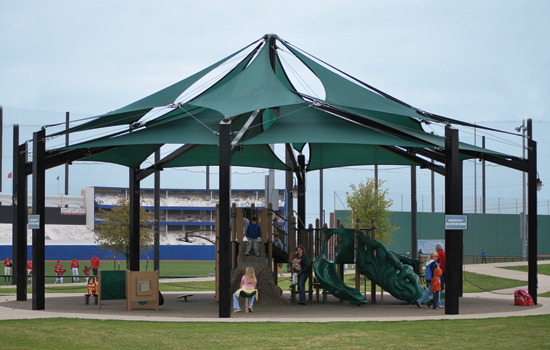Architecture Extraordinaire: A Primer on Fabric Structures
Ethylene tetrafluoroethylene (ETFE). This ultra-high transparency material (97 percent) has a life span of more than 25 years. While this is considered an architectural fabric, there is no woven substrate, thus giving it such a high translucency factor. The elimination of the substrate also comparatively reduces its tensile strength. It is self-cleaning and 100 percent recyclable, and can be deployed in single or multiple layers. ETFE is not really a fabric, but is a film presently promoted as an alternative to glass. It is “green” friendly and is considered to be the hot new architectural fabric internationally. ETFE fabrics have been used or are being specified in high-profile mega projects worldwide, including the FIFA stadiums in Germany, the Olympic venues in China, governmental buildings in Washington, D.C., and have become the preferred choice in creating enclosures for artificial rainforest and water parks in colder climates. ETFE pricing can average between $125 and $185 per square foot.
Vinyl coated polyester (PVC/PVDF). Of all the shade fabrics, PVC/PVDF is the most common material used on the market today. It is suitable for both temporary and permanent structures. The woven substrate material is polyester, which makes it soft, pliable and easy to handle, and is available in a variety of colors, weights, topcoats and textures. PVC with a PVDF topcoat has a typical life span of more than 20 years and is fire resistant (Class C, NFPA 701). The majority of fabric structures being considered today are for uses which do not require complete enclosure— that is, they are most likely “open air” or do not require a Class A rating. Class C is the most common rating and NFPA 701 is the most accepted certificate for most fire marshals. PVC/PVDF pricing can average between $65 and $120 per square foot.
High density polyethylene (HDPE). Today, more and more fabric structures are being designed for shade only, with structural mesh fabrics being specified as the preferred membrane. The material most often used is high density polyethylene (HDPE) mesh. This fabric is a shade fabric, which does not have a woven substrate. It provides up to 84 percent shade, 92 percent UV Protection, and approximately 85 percent water run-off, depending on shape, and has a life expectancy of 12 to 15 years. This UV stable fabric comes in a variety of styles, colors and shade factors. It has a high tensile strength and can be fire-resistant if required. Well suited for dry/hot climates, the HDPE cloth also offers protection from sun and hail and is relatively inexpensive. HDPE pricing can average between $18 and $60 per square foot.

Photo courtesy of Shade Structures, Inc.
HDPE is an UV stable fabric that offers protection from the weather.
The Next Generation of Fabric Architecture—Some Trends
The fabric architecture industry is one that is constantly innovating to create more options with ever greater sustainability, aesthetic appeal and functionality. Custom colors, textures and patterns are being used for multipurpose structures, and strides have been made in using fabric to produce energy. Currently, photovoltaic film can be applied to fabric to harness power from the sun. In the next generation for photovoltaic application in the fabric architecture industry, designers will be developing the capacity for tensile strength fabrics to have PV “receptors” woven directly into the fabric, while still maintaining its tensile strength. Or, PV films will be developed to meet tensile strength qualities and requirements.
Building with Fabric: Architecture for the Future
While fabric structures have been around since the cave man, they hold enormous potential for future applications. Architects would do well to educate their clients on the benefits of these striking, sustainable forms. With attributes such as low energy requirements, high environmental performance, low costs and high design capability, fabric structures embody those parameters that green builders desire and that green rating systems reward. Of utmost importance is the potential contribution of fabric structures to human health and well being. In terms of providing shade in outdoor spaces, fabric structures constitute a key asset in preventing harmful effects of the sun, particularly on children. As materials become more advanced, and as the structures themselves more multi-functional, fabric architecture will realize its fullest potential to the benefit of architects, users, owners, and the environment.

|
USA Shade |








